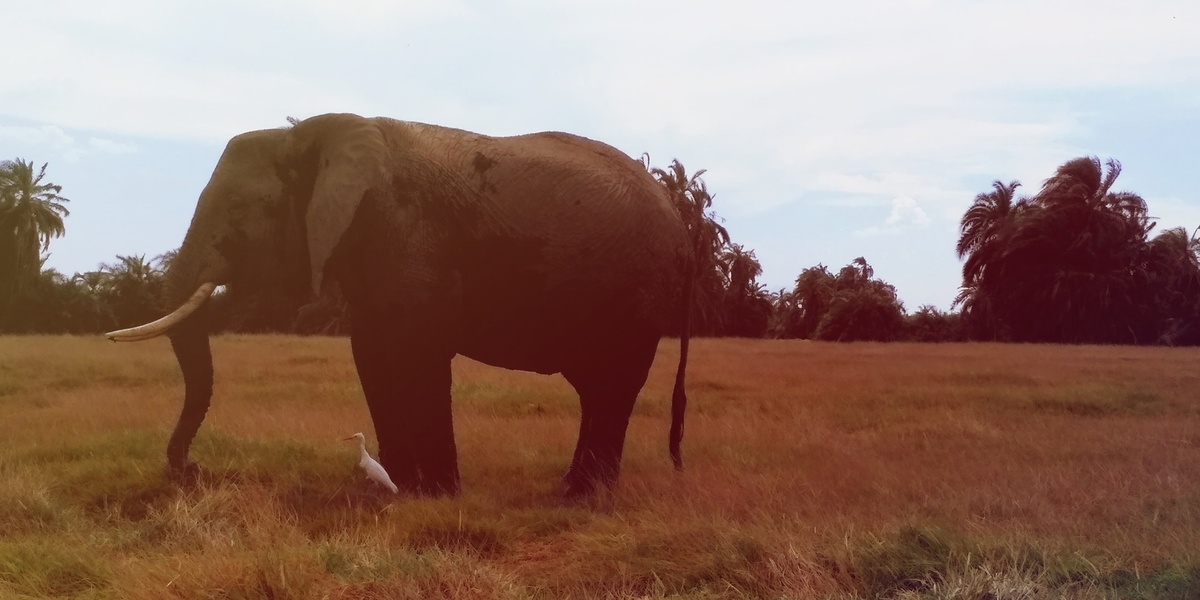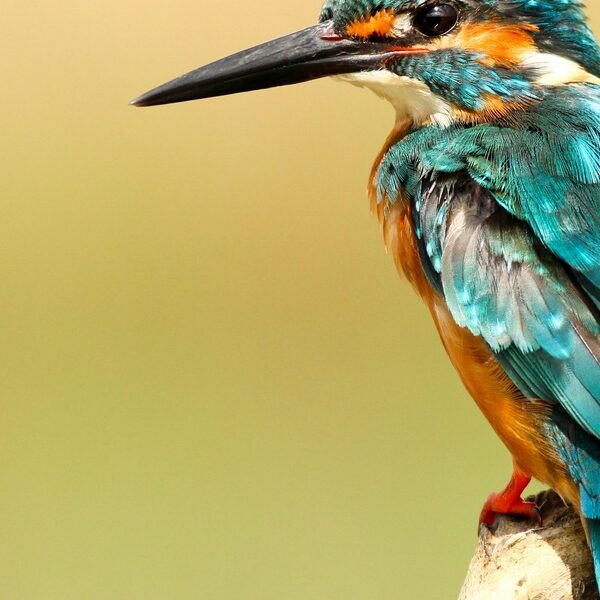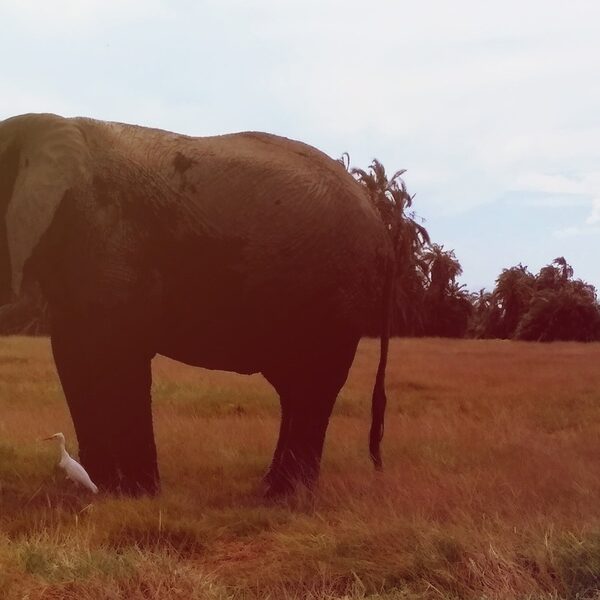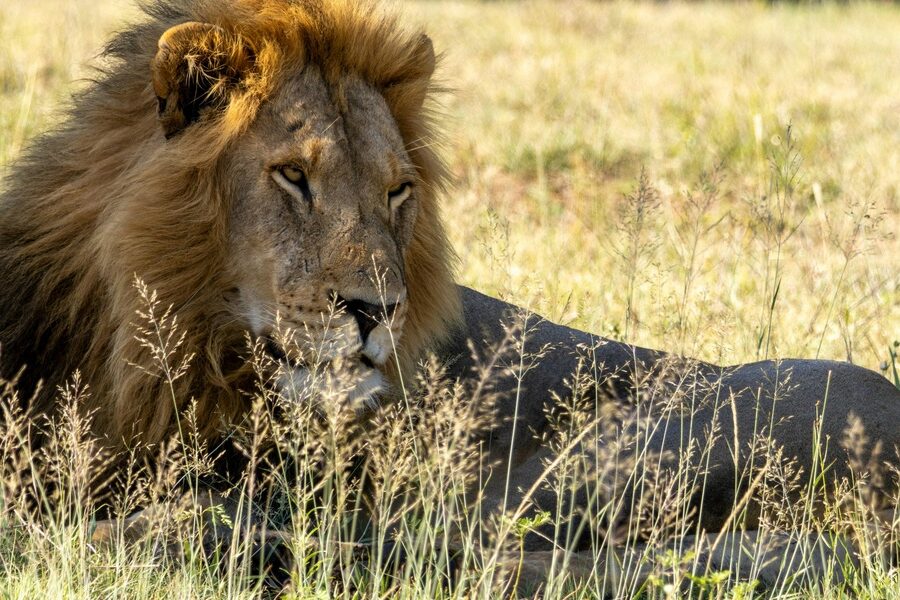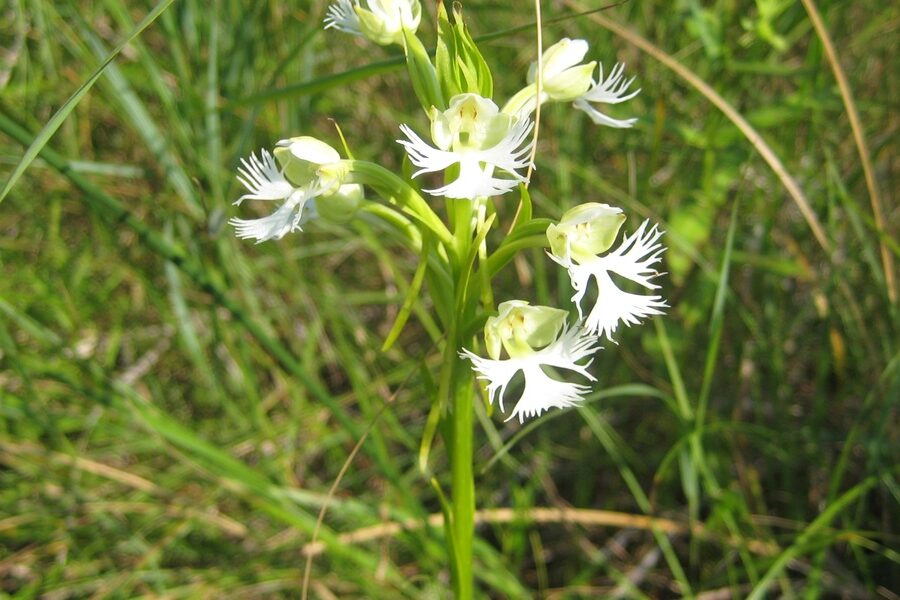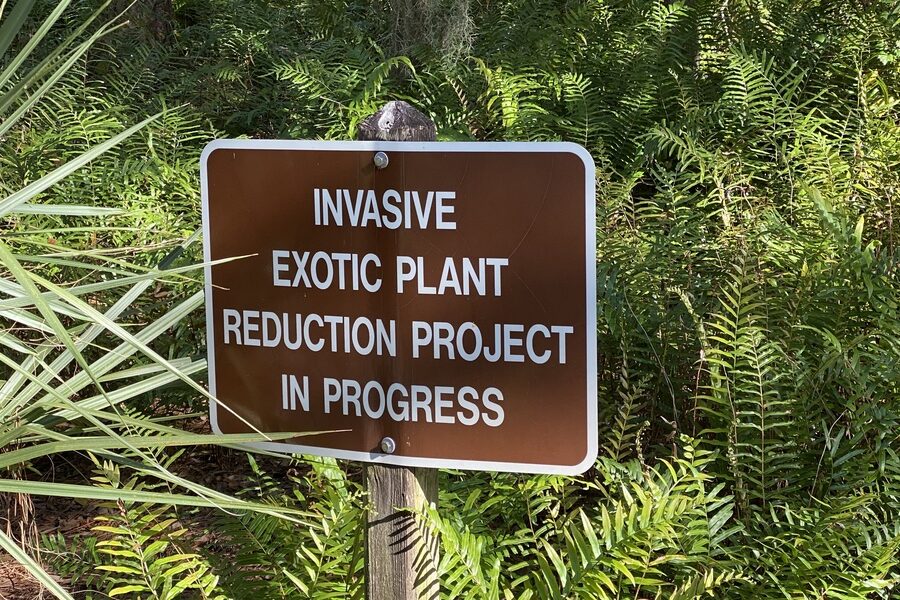Burkina Faso sits where Sahelian grasslands meet Sudanian woodlands, giving rise to a varied set of mammals adapted to seasonal rains, gallery forests and protected reserves. From larger grazers to small nocturnal species, the country’s fauna reflects both West African diversity and the pressures of land use and climate.
There are 58 Mammals of Burkina Faso, ranging from Aardvark to Yellow-winged bat. For each, the data are organized as Scientific name,IUCN status,Habitat & in-country range — you’ll find these details below.
How current and reliable are the IUCN statuses listed here?
The IUCN status column reflects published Red List assessments and widely used conservation sources; statuses can change with new surveys, so treat them as a baseline and consult the IUCN Red List or recent local studies for the latest updates before making management or research decisions.
Can this list help me plan wildlife-watching or fieldwork in Burkina Faso?
Yes — use the Habitat & in-country range column to target likely locations and seasons for species, but also contact local guides, obtain necessary permits, and account for nocturnal habits or rarity of some species; protected areas and water sources are often the best starting points.
Mammals of Burkina Faso
| Common name | Scientific name | IUCN status | Habitat & in-country range |
|---|---|---|---|
| African bush elephant | Loxodonta africana | Endangered | Savannas and woodlands, primarily in the W-Arly-Pendjari Complex in the east. |
| Lion | Panthera leo | Vulnerable | Savannas and open woodlands, now restricted to the W-Arly-Pendjari Complex. |
| Leopard | Panthera pardus | Vulnerable | Adaptable; found in savannas, forests, and rocky hills across the country. |
| Spotted hyena | Crocuta crocuta | Least Concern | Widespread in savannas and woodlands, especially common in protected areas. |
| African wild dog | Lycaon pictus | Endangered | Savannas and open woodlands, now extremely rare, confined to the eastern protected areas. |
| Cheetah | Acinonyx jubatus | Vulnerable | Open savannas and grasslands; historically present, now extremely rare or extirpated. |
| Aardvark | Orycteropus afer | Least Concern | Widespread in savannas and woodlands with soft soil, but rarely seen. |
| African buffalo | Syncerus caffer | Near Threatened | Savannas and woodlands near water, mainly in protected areas in the south and east. |
| Roan antelope | Hippotragus equinus | Least Concern | Wooded savannas and grasslands, particularly in central, southern, and eastern protected areas. |
| Western hartebeest | Alcelaphus buselaphus major | Near Threatened | Open savannas and grasslands, primarily found in protected areas. |
| Kob | Kobus kob | Least Concern | Floodplains and savannas near water sources, particularly in southern and eastern regions. |
| Bushbuck | Tragelaphus scriptus | Least Concern | Forests, woodlands, and dense riverine bush throughout the country. |
| Common duiker | Sylvicapra grimmia | Least Concern | Widespread in savannas and woodlands with sufficient cover. |
| Oribi | Ourebia ourebi | Least Concern | Open grasslands and light woodlands, found in scattered populations across the country. |
| Olive baboon | Papio anubis | Least Concern | Widespread in savannas, open woodlands, and rocky areas. |
| Patas monkey | Erythrocebus patas | Near Threatened | Open savannas and semi-desert areas, particularly in the Sahelian north. |
| Tantalus monkey | Chlorocebus tantalus | Least Concern | Savannas, woodlands, and riverine forests across the country. |
| West African giraffe | Giraffa camelopardalis peralta | Vulnerable | Sahelian savannas; a small, isolated population exists in the W National Park region. |
| Hippopotamus | Hippopotamus amphibius | Vulnerable | Rivers, lakes, and wetlands in southern and eastern Burkina Faso. |
| Common warthog | Phacochoerus africanus | Least Concern | Widespread in grasslands, savannas, and woodlands. |
| African civet | Civettictis civetta | Least Concern | Widespread in forests, woodlands, and dense savannas. |
| Common genet | Genetta genetta | Least Concern | Widespread in savannas, woodlands, and even near human settlements. |
| White-tailed mongoose | Ichneumia albicauda | Least Concern | Widespread in savannas and woodlands across the country. |
| Gambian mongoose | Mungos gambianus | Least Concern | Wooded savannas in western and southern regions. |
| Cape hare | Lepus capensis | Least Concern | Widespread in open grasslands, savannas, and semi-desert areas. |
| African brush-tailed porcupine | Atherurus africanus | Least Concern | Forests and dense woodlands in the south and west. |
| Striped ground squirrel | Euxerus erythropus | Least Concern | Widespread in savannas, grasslands, and cultivated areas. |
| Gambian pouched rat | Cricetomys gambianus | Least Concern | Widespread in a variety of habitats, including near human areas. |
| Caracal | Caracal caracal | Least Concern | Savannas and semi-desert areas, widespread but secretive. |
| Serval | Leptailurus serval | Least Concern | Well-watered savannas and grasslands, particularly in the south. |
| Side-striped jackal | Lupulella adusta | Least Concern | Woodlands and savannas, particularly in southern and eastern regions. |
| Honey badger | Mellivora capensis | Least Concern | Widespread in various habitats from savanna to forest, but elusive. |
| Striped polecat | Ictonyx striatus | Least Concern | Widespread in savannas and grasslands. |
| Rock hyrax | Procavia capensis | Least Concern | Rocky outcrops and hills (kopjes) across the country. |
| Senegal galago | Galago senegalensis | Least Concern | Widespread in dry woodlands and savanna bushland. |
| Egyptian fruit bat | Rousettus aegyptiacus | Least Concern | Caves and human structures near fruit sources, widespread. |
| Straw-coloured fruit bat | Eidolon helvum | Near Threatened | Migratory; forms massive seasonal colonies in trees across the country. |
| Hammer-headed fruit bat | Hypsignathus monstrosus | Least Concern | Forest and riverine habitats in the southwest. |
| Yellow-winged bat | Lavia frons | Least Concern | Savannas and woodlands near water, often seen roosting in acacia trees. |
| Slit-faced bat | Nycteris hispida | Least Concern | Widespread in savannas and forests, roosting in hollow trees or burrows. |
| Mauritian tomb bat | Taphozous mauritianus | Least Concern | Widespread, roosts on buildings, tree trunks, and rock faces. |
| Red-flanked duiker | Cephalophus rufilatus | Least Concern | Savannas and woodland edges, preferring areas with thick cover. |
| Waterbuck | Kobus ellipsiprymnus | Least Concern | Savannas and woodlands near permanent water sources. |
| Pangolin | Smutsia sp. | Critically Endangered | Savannas and woodlands; extremely rare and secretive. |
| Western tree hyrax | Dendrohyrax dorsalis | Least Concern | Forest patches in the south and west of the country. |
| Four-toed sengi | Petrodromus tetradactylus | Least Concern | Forest and dense woodland undergrowth in the south. |
| Marsh mongoose | Atilax paludinosus | Least Concern | Permanent wetlands, rivers, and marshes throughout the country. |
| Hausa genet | Genetta thierryi | Least Concern | Moist and dry savannas, particularly in the northern half of the country. |
| African clawless otter | Aonyx capensis | Near Threatened | Rivers and freshwater wetlands in southern and eastern protected areas. |
| Spotted-necked otter | Hydrictis maculicollis | Near Threatened | Permanent freshwater bodies like rivers and lakes, mainly in the south. |
| Fat mouse | Steatomys sp. | Least Concern | Savannas and grasslands across the country. |
| Naked-rumped tomb bat | Taphozous nudiventris | Least Concern | Dry savannas and semi-desert areas, roosts in cliffs and buildings. |
| Lesser woolly bat | Kerivoula lanosa | Least Concern | Savanna woodlands and riverine forests. |
| Angolan free-tailed bat | Mops condylurus | Least Concern | Widespread in savannas, often roosts in buildings. |
| Egyptian slit-faced bat | Nycteris thebaica | Least Concern | Widespread in savannas, roosting in caves, mines, and hollow trees. |
| Guinean baboon | Papio papio | Near Threatened | Dry forests and woodlands in the far southwestern corner of the country. |
| Bush hyrax | Heterohyrax brucei | Least Concern | Rocky outcrops (kopjes) and hills, often co-existing with rock hyraxes. |
| Vervet monkey | Chlorocebus pygerythrus | Least Concern | Savannas and woodlands, especially near rivers, across the country. |
Images and Descriptions
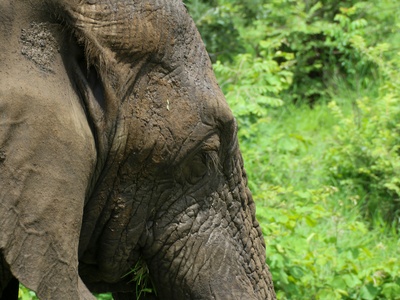
African bush elephant
The world’s largest land animal, known for its massive size and trunk. These ecosystem engineers are crucial for seed dispersal and creating pathways, but their populations in Burkina Faso are small and threatened by poaching and habitat loss.
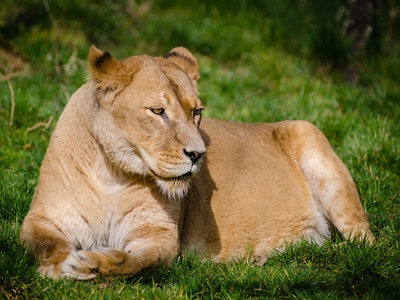
Lion
Africa’s largest predator and the only truly social cat. Lions live in prides and are apex predators essential for ecosystem health. The West African subspecies found here is critically endangered, facing immense pressure from human-wildlife conflict.
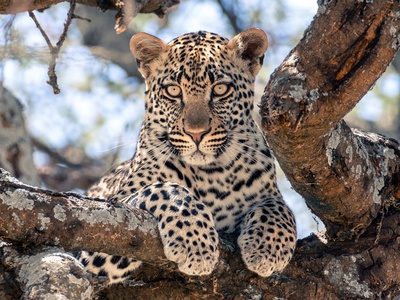
Leopard
A powerful and elusive big cat known for its spotted coat and incredible strength. Leopards are solitary, nocturnal hunters with a highly varied diet. They are adaptable but threatened by habitat loss and conflict with humans over livestock.
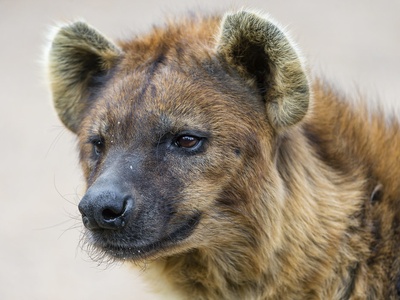
Spotted hyena
Often misunderstood, the spotted hyena is an intelligent social carnivore with a powerful bite. Living in female-dominated clans, they are both skilled hunters and efficient scavengers, playing a vital role in cleaning the ecosystem.
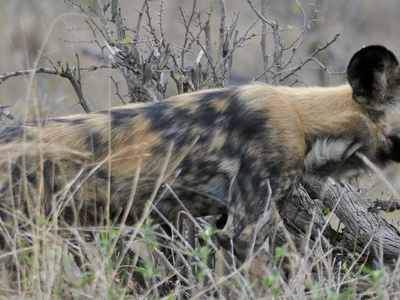
African wild dog
Known for its unique, colorful coat and large, rounded ears. African wild dogs are highly social pack hunters that travel vast distances. They are one of Africa’s most endangered carnivores due to disease and habitat fragmentation.
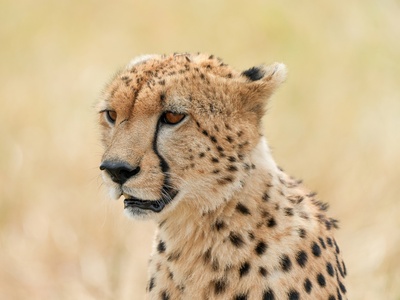
Cheetah
The world’s fastest land animal, built for incredible bursts of speed to catch prey. Cheetahs are easily distinguished by their slender bodies and black “tear marks.” Their survival is threatened by habitat loss and competition with larger predators.
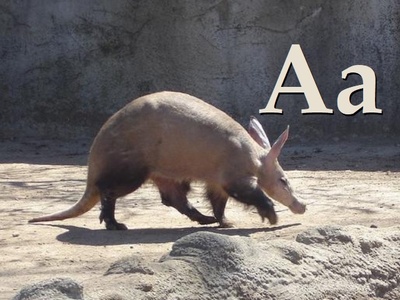
Aardvark
A unique, nocturnal mammal with powerful claws for digging and a long snout for feeding on ants and termites. Despite its pig-like appearance, it’s the only living species in its order, spending its days in deep underground burrows.
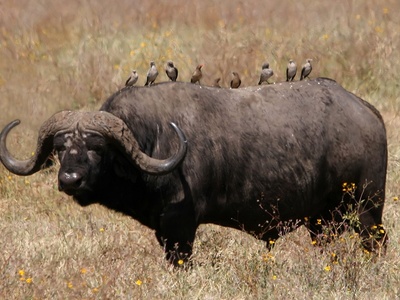
African buffalo
A large, formidable bovid with distinctive, heavy horns that fuse at the base. African buffalo live in large herds and are known for their unpredictable and defensive nature. They are a keystone species for both predators and the ecosystem.
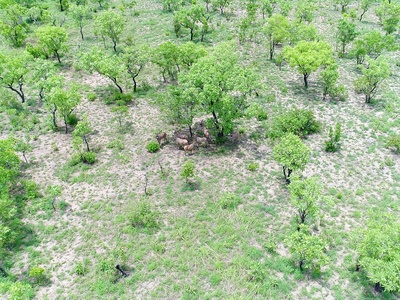
Roan antelope
A large, handsome antelope with a distinctive black-and-white face mask and long, backward-curving horns. Roan antelopes are social animals that live in small herds and are known for their impressive size and striking appearance.
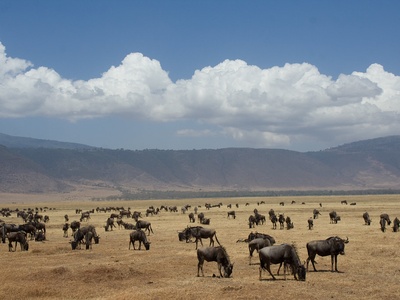
Western hartebeest
A large, reddish-brown antelope with a long face and oddly shaped, bracket-like horns. Hartebeests are incredibly fast runners, capable of reaching high speeds to escape predators in their open savanna habitat. They are predominantly grazers.
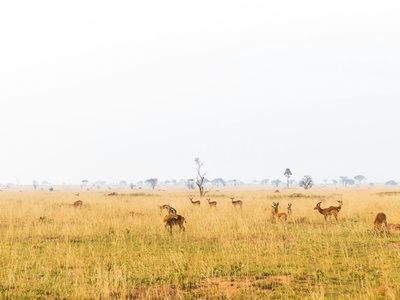
Kob
A medium-sized, sturdy antelope where males have lyre-shaped horns. Kobs are gregarious and often form large herds. They are known for their “lekking” grounds, where males gather to perform elaborate displays to attract females.
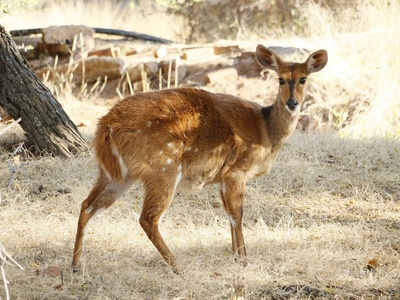
Bushbuck
A medium-sized antelope with a beautiful coat marked with white spots and stripes for camouflage. Bushbucks are shy, solitary animals, typically active at dawn and dusk. They are browsers, feeding on leaves, herbs, and shoots.
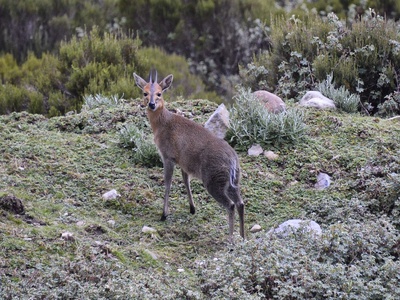
Common duiker
A small, adaptable antelope known for its characteristic diving (“duiker” in Afrikaans) motion into bushes when threatened. They are solitary browsers and grazers with a very broad diet, allowing them to thrive in various habitats.
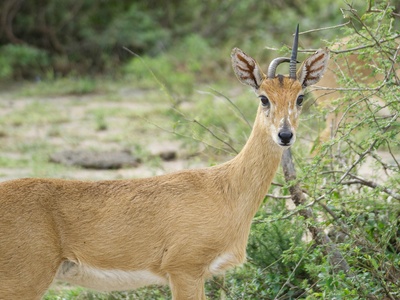
Oribi
A small, slender antelope with long legs and neck, perfectly adapted for life in open grasslands. Oribis are known for their “stotting” behavior, where they leap into the air with all four legs stiff to signal alarm.
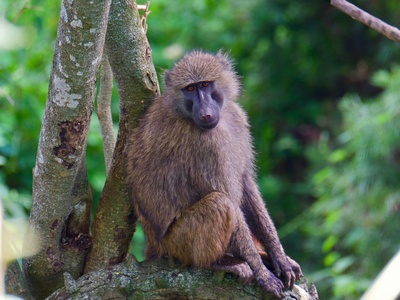
Olive baboon
A large, highly adaptable monkey that lives in complex social groups called troops. They are omnivorous, spending much of their day foraging on the ground for roots, insects, and small animals. Their intelligence allows them to thrive near humans.
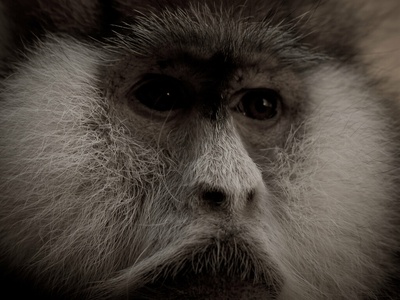
Patas monkey
Known as the “military monkey,” this is the fastest primate, built for life on the ground. Patas monkeys have long limbs and a reddish coat, living in small groups and feeding on insects, seeds, and fruits.
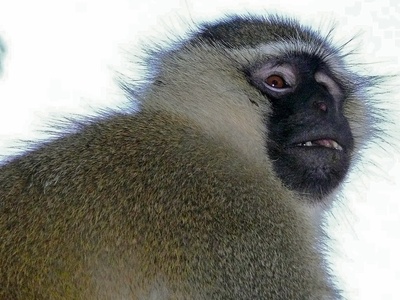
Tantalus monkey
A medium-sized monkey with a greenish-grey coat and a distinctive black face with a white brow band. Tantalus monkeys are social animals that live in groups and are often seen foraging on the ground as well as in trees.
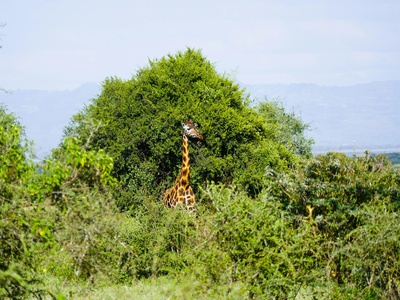
West African giraffe
A subspecies of the world’s tallest mammal, distinguished by its light-colored spots. These gentle giants are browsers, using their long necks to reach acacia leaves. The West African population is critically small and a major conservation priority.
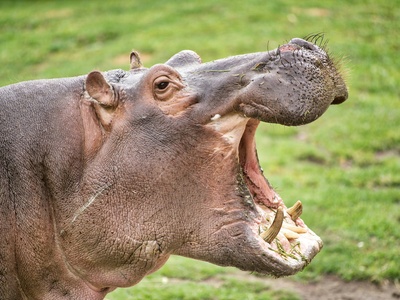
Hippopotamus
A large, semi-aquatic mammal that spends its days in water to stay cool and emerges at night to graze. Despite their placid appearance, hippos are highly territorial and one of Africa’s most dangerous animals.
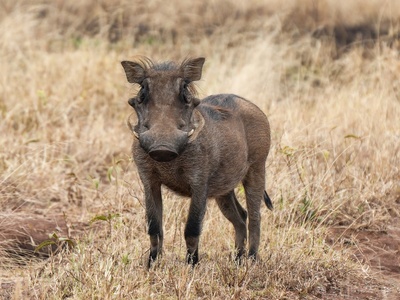
Common warthog
A wild pig famous for its facial warts and upward-curving tusks. Warthogs are diurnal animals that live in family groups called sounders. They often kneel on their front legs to graze and use burrows for shelter.
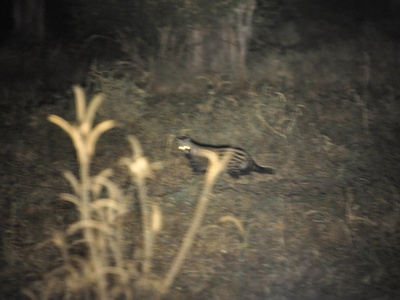
African civet
A large, solitary, nocturnal mammal with a striking black-and-white coat. The African civet produces a strong-smelling musk from its perineal glands, historically used in perfumery. It is an omnivore with a varied diet of insects, fruits, and small animals.
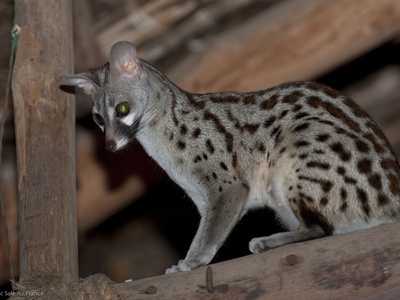
Common genet
A slender, cat-like carnivore with a spotted coat, a long banded tail, and a pointed face. Genets are agile, nocturnal hunters that prey on small mammals, birds, and insects. They are excellent climbers but spend much of their time hunting on the ground.
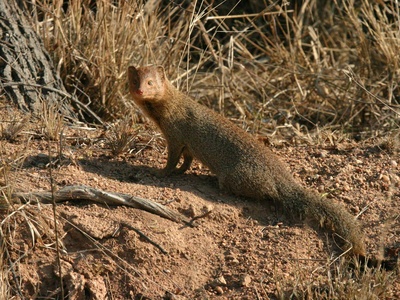
White-tailed mongoose
A large, long-legged mongoose easily identified by its bushy white tail, which it holds erect when alarmed. This nocturnal and solitary hunter feeds on insects, snakes, and small rodents, playing an important role in controlling their populations.
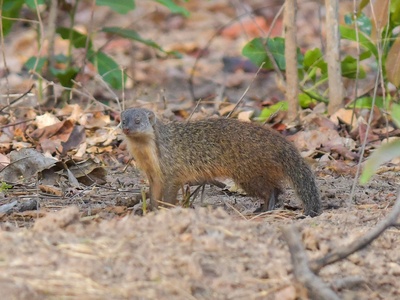
Gambian mongoose
A highly social mongoose that lives in large family groups of up to 40 individuals. They are diurnal, foraging together for insects, crabs, and small vertebrates. Their cooperative lifestyle helps them defend against predators and find food.
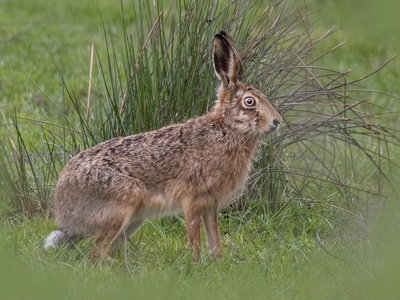
Cape hare
A fast and agile hare with long ears tipped in black and powerful hind legs for escaping predators. Cape hares are nocturnal and solitary, feeding on grasses and herbs. Their incredible speed is their primary defense mechanism.
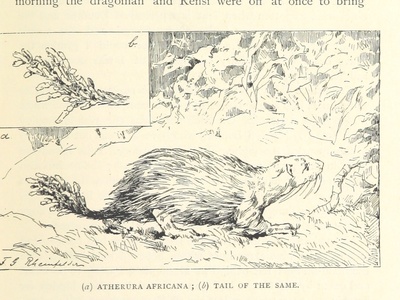
African brush-tailed porcupine
A large rodent covered in sharp, dark quills. Unlike other porcupines, its quills are shorter, and it has a distinctive cluster of hollow quills on its tail that it rattles as a warning. It is nocturnal and feeds on plants.
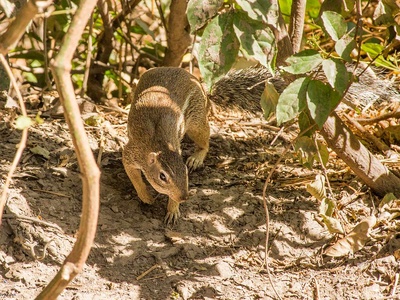
Striped ground squirrel
A common diurnal rodent often seen foraging on the ground. It has a distinctive white stripe running along its side and a bushy tail. These squirrels live in burrows and feed on seeds, roots, and insects.
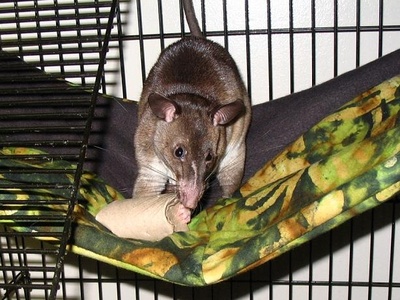
Gambian pouched rat
A very large, nocturnal rodent known for its massive cheek pouches, which it uses to transport food. Despite its size, it is a skilled climber. These rats are famous for being trained to detect landmines and tuberculosis.
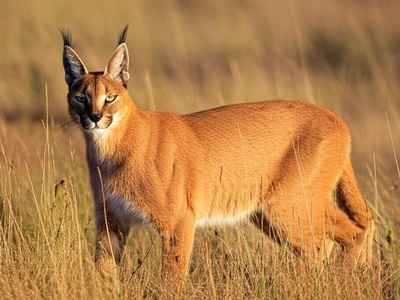
Caracal
A medium-sized wild cat with a reddish-tan coat, long legs, and distinctive long, black ear tufts. Caracals are powerful hunters, known for their incredible ability to leap into the air to catch birds in mid-flight.
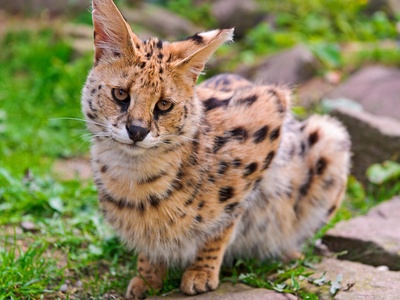
Serval
A slender, long-legged wild cat with a spotted coat and very large ears used to detect prey underground. Servals are specialist hunters of small rodents and birds, using a high pounce to stun their prey.
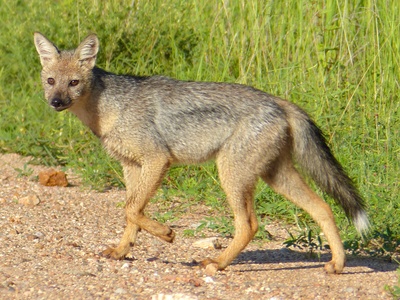
Side-striped jackal
A medium-sized canid with a faint stripe along its flanks. More of an omnivorous scavenger than a hunter, its diet consists heavily of fruits and insects, along with small animals. It is typically less aggressive than other jackal species.
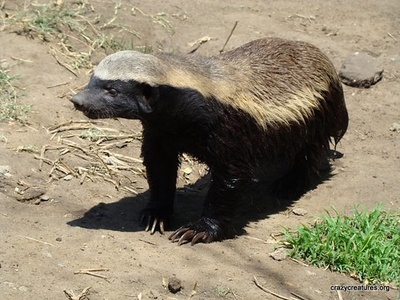
Honey badger
Renowned for its strength, ferocity, and thick, protective skin. The honey badger is a tenacious omnivore that will eat almost anything, from insects and snakes to roots and berries. It is famously known for raiding beehives.
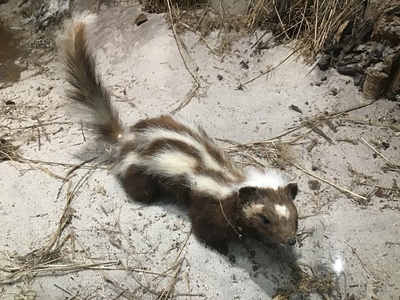
Striped polecat
Also known as the zorilla, this small carnivore resembles a skunk with its bold black-and-white stripes. When threatened, it can spray a foul-smelling fluid from its anal glands. It is a nocturnal hunter of small rodents and insects.
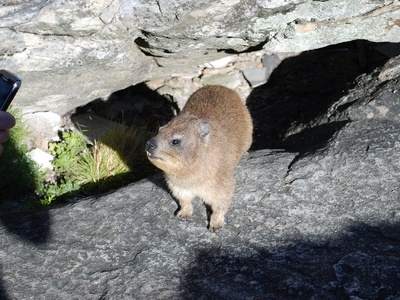
Rock hyrax
A small, rodent-like mammal that is surprisingly the elephant’s closest living relative. Rock hyraxes are social, living in large colonies. They spend their days basking on rocks and feeding on vegetation, with sentries watching for predators.
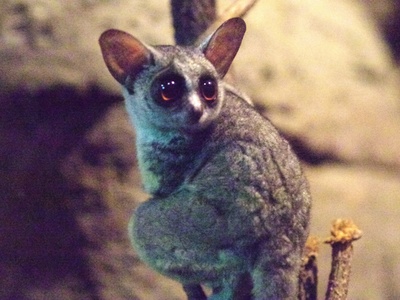
Senegal galago
Also known as a bushbaby, this small, nocturnal primate has huge eyes for excellent night vision and large ears to track insects. It is an agile leaper, using its powerful hind legs to jump between trees.
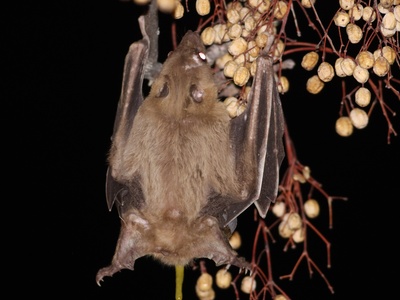
Egyptian fruit bat
A large fruit bat that lives in massive colonies, sometimes numbering in the thousands. Unlike most fruit bats, it uses a simple form of echolocation (tongue-clicking) to navigate in the dark caves where it roosts during the day.
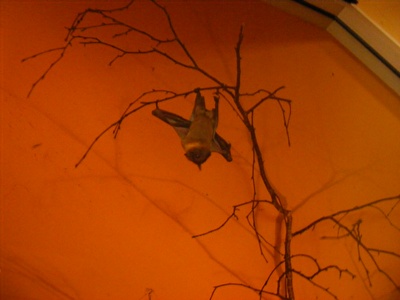
Straw-coloured fruit bat
One of Africa’s most widespread fruit bats, known for forming enormous, noisy colonies in tall trees. These bats are vital for pollination and seed dispersal over long distances, making them a keystone species for forest regeneration.
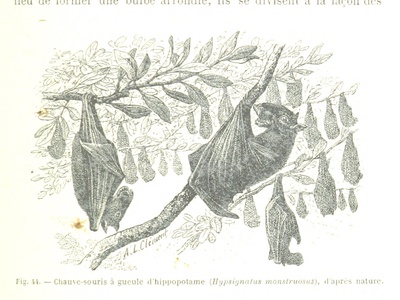
Hammer-headed fruit bat
The largest bat in mainland Africa, with males possessing a bizarre, moose-like head and producing loud, honking calls to attract females. They gather in communal leks, making them a fascinating example of bat social behavior.
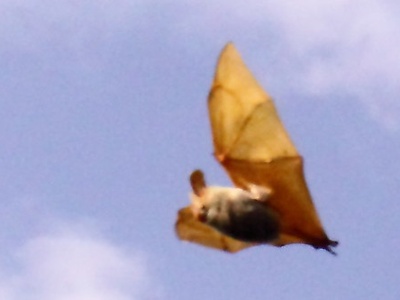
Yellow-winged bat
A visually stunning bat with bright yellow or orange wings and ears that contrast with its grey body. It is a carnivorous bat that hunts large insects at dusk, often from a perch like a shrike.
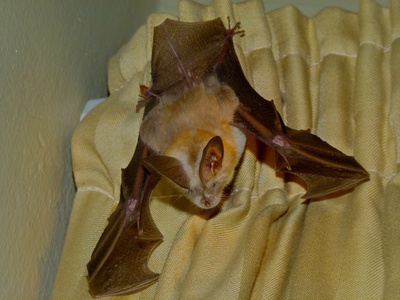
Slit-faced bat
Named for the long slit or groove running down its face, this small bat has very broad wings, allowing for slow, maneuverable flight. It is an insectivore that often gleans spiders and insects directly from foliage.
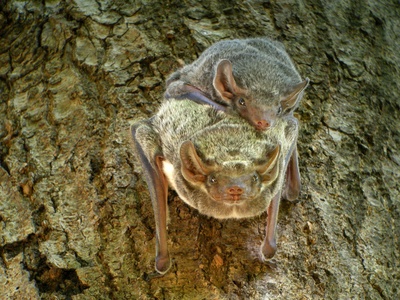
Mauritian tomb bat
A sleek, medium-sized insectivorous bat with a whitish belly. It gets its name from its habit of roosting in the open on vertical surfaces, flattening itself against the substrate. It is a fast flier that hunts insects in open air.
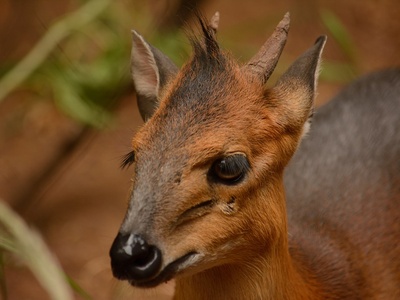
Red-flanked duiker
A small, shy antelope with a reddish-brown coat and a dark stripe down its back. As with other duikers, it is a browser that feeds on leaves, fruits, and flowers, often diving into dense vegetation when startled.
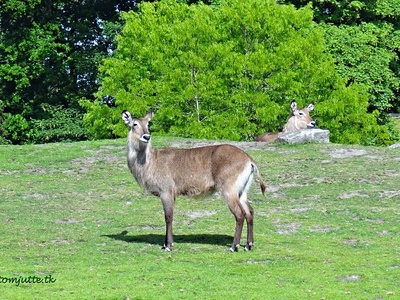
Waterbuck
A large, shaggy-coated antelope easily identified by the white ring around its neck or a white patch on its throat. Males have long, ringed horns that curve forward. They have a greasy, waterproof coat with a musky smell.
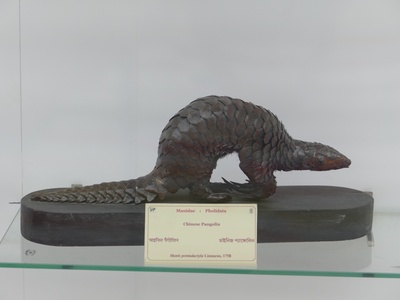
Pangolin
Pangolins are unique mammals covered in protective keratin scales. They are nocturnal and feed exclusively on ants and termites using a long, sticky tongue. They are the most trafficked mammals in the world, facing extinction from poaching.
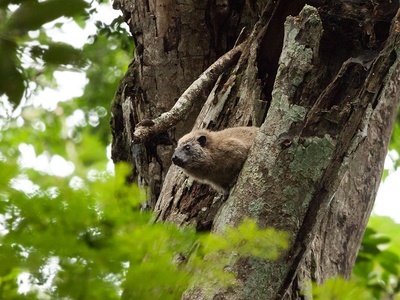
Western tree hyrax
A nocturnal, tree-dwelling relative of the rock hyrax. It is solitary and known for its loud, screaming calls at night. It has a glandular scent patch on its back and feeds on leaves, fruits, and buds.
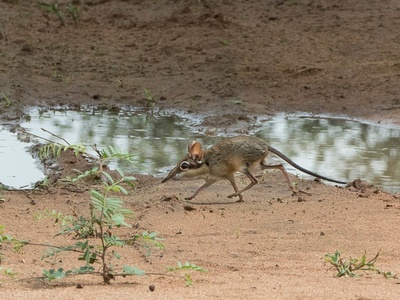
Four-toed sengi
Also known as an elephant shrew, this small insectivorous mammal is more closely related to elephants than shrews. It has a long, flexible snout for probing for insects and uses a network of cleared paths to escape predators.
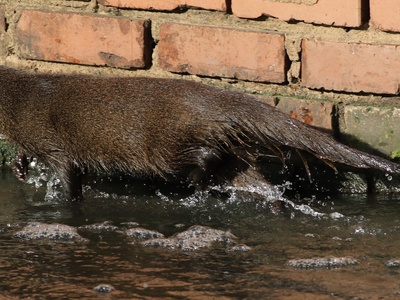
Marsh mongoose
A large, robust mongoose with a dark, shaggy coat. It is semi-aquatic and an excellent swimmer, using its sensitive paws to feel for prey like crabs, frogs, and fish in muddy water and under rocks.
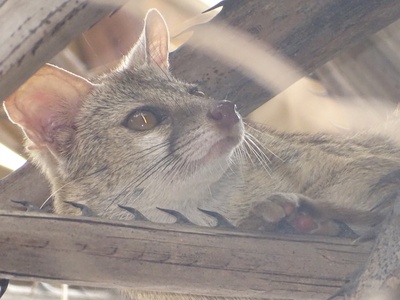
Hausa genet
A small, slender genet adapted to drier savanna habitats. It is less reliant on dense forests than other genet species. It is a nocturnal and solitary hunter, preying on small vertebrates and insects.
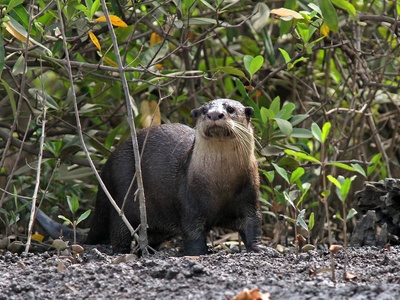
African clawless otter
A large freshwater otter that lacks prominent claws, using its dextrous forepaws to find and handle prey like crabs, fish, and frogs. It is mostly nocturnal or crepuscular and lives in small family groups.
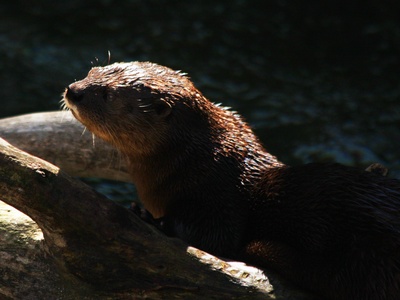
Spotted-necked otter
A smaller otter species with distinctive white or cream-colored blotches on its throat and chest. It is highly aquatic and a social animal, often seen hunting for fish in groups during the day.
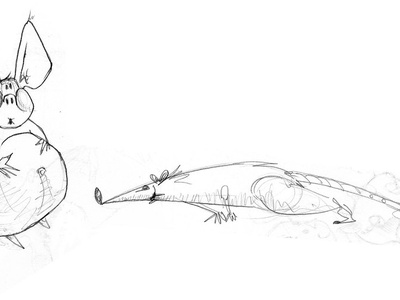
Fat mouse
A small, burrowing rodent known for its ability to accumulate large amounts of body fat, especially before the dry season. This fat reserve allows it to survive periods when food is scarce.
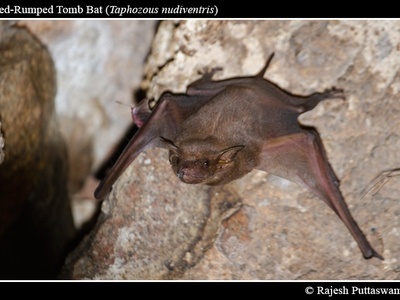
Naked-rumped tomb bat
A large tomb bat that forms colonies in hot, dry regions. It is a high-altitude, fast-flying insectivore. Its name comes from the lack of fur on its lower back and rump area.
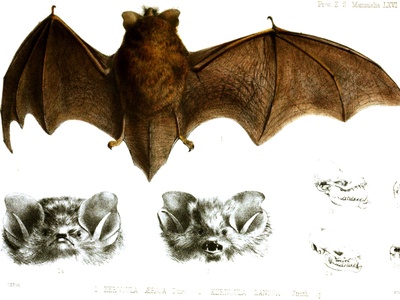
Lesser woolly bat
A small, delicate bat with long, woolly fur. It has a distinctive high-domed skull and is an aerial insectivore, catching insects in flight with its slow, fluttering style. It often roosts in old birds’ nests.
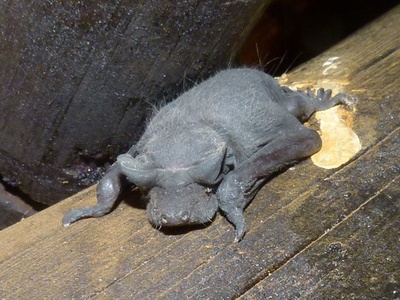
Angolan free-tailed bat
A common, robust free-tailed bat that can form very large colonies in man-made structures. It is a fast-flying insectivore that forages high above the ground. It is known to be a potential reservoir for Ebola-related viruses.
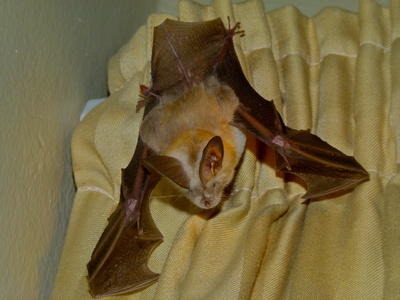
Egyptian slit-faced bat
A highly adaptable bat found across Africa. It is known for its maneuverable, butterfly-like flight, which allows it to hunt insects very close to the ground and even glean them directly from surfaces.
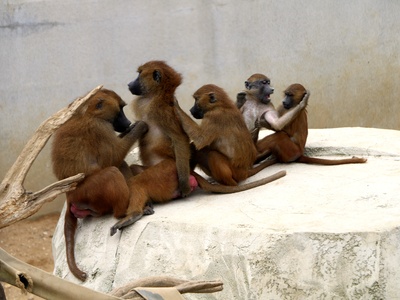
Guinean baboon
The smallest baboon species, with reddish-brown fur. Like other baboons, it lives in large, multi-male, multi-female groups with a complex social structure. Its range barely extends into Burkina Faso from neighboring countries.
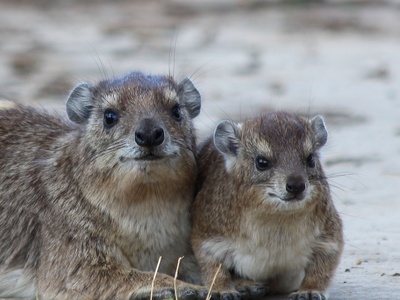
Bush hyrax
Also known as the yellow-spotted rock hyrax, this species is smaller and more slender than the rock hyrax. It is a social, diurnal browser that lives in colonies among boulders, feeding on leaves and shoots.
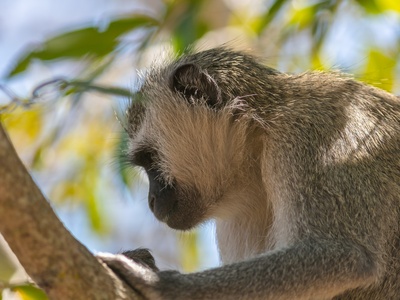
Vervet monkey
A familiar monkey with a black face and grey body. Vervets are highly social and intelligent, living in troops and using a complex system of alarm calls to warn others of specific predators like leopards, eagles, and snakes.
